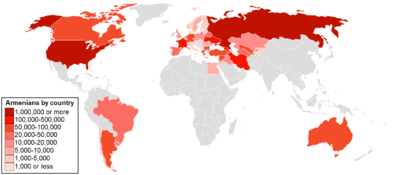Armenians in Germany
| Total population | |
|---|---|
| (40,000 - 42,000 [1]) | |
| Regions with significant populations | |
| North Rhine-Westphalia, between the cities of Cologne and Düsseldorf, Hesse (here majority of Armenians living in Frankfurt) and Hamburg, Sufficiently strong Armenian community in Berlin (about 2,000 people) [2] and Munich, which are also fairly typical places of residence immigrants. | |
| Languages | |
| Armenian, German | |
| Related ethnic groups | |
| Armenian diaspora | |
|
|
Armenians in Germany are ethnic Armenians living within the modern republic of Germany. Like much of the Armenian diaspora, most Armenians immigrated to Germany after the Armenian Genocide of 1915. Others came later, fleeing conflicts in places like Iran, Azerbaijan and Lebanon. Another influx came fleeing nationalist persecution in Turkey. After World War II, many Soviet Armenians, former POWs in particular, fled to the American occupied areas of Germany. While many traveled on, some settled in the country, providing a base for later asylum-seekers.[4]
History
The first Armenian organization was the Armenian Colony of Berlin, established in 1923.[4] By 1975, Armenian associations would be established in Hamburg, Berlin, Cologne, Frankfurt, Stuttgart and Munich. In the 1980s, other associations were created in Bremen, Braunschweig, Bielefeld, Duisburg, Neuwied, Bonn, Hanau, Eppingen, Nuremberg, Kehl and elsewhere.[4]
Presently, there are about 25,000 naturalized Armenians and 15,000 asylum-seeking Armenians living in Germany today. Their population is concentrated in Mecklenburg-Western Pomerania, many of which are Armenian asylum-seekers from Armenia, for whom the Armenian Church provides services, baptisms, Bible readings and community support. The Diocese of Germany bears all the costs of supporting Armenians from post-Soviet Armenia and regards this service as part of its mission.[4]
Germany and the Armenian Genocide
While the German parliament has adopted a resolution that recognizes the "organized expulsion and destruction of the Armenians", and states that "numerous independent historians, parliaments and international organizations" have recognized the event as genocide, the resolution does not state such itself. The resolution also contains an apology for Germany's role in the Genocide (The German Monarchy was an ally of Ottoman Turkey during World War I, and did not intervene despite ample evidence of a policy of extermination) and calls on Turkey to examine its role in the ethnic cleansing.[5]
This resolution is deemed significant due to the comparatively large number of Turkish nationals living in Germany.
See also
References
- ↑ (Russian) АРМЯНСКАЯ ДИАСПОРА ГЕРМАНИИ: ОТ НЕПРИЗНАНИЯ К ИНТЕГРАЦИИ in "Noravank" Scientific-Research Foundation
- ↑ Hofmann T., Armenier und Berlin – Berlin und Armenien. – Berlin, 2005. S. 4.
- ↑ Armenian diaspora in Germany (PDF), Yerevan: ="Noravank" Scientific-Research Foundation, 2006
- 1 2 3 4 Armenian Reporter Online
- ↑ Germans press Turks on Armenian slaughter - International Herald Tribune
External links
- Armenier Rhein-Main (Armenians in the Rhein-Main Area)
- Zentralrat der Armenier in Deutschland (Central Council of Armenians in Germany)
- Deutsch-Armenische Gesellschaft (German-Armenian Society)
- Armenisch-Deutsche Korrespondenz (ADK) Quarterly of the German-Armenian Society
